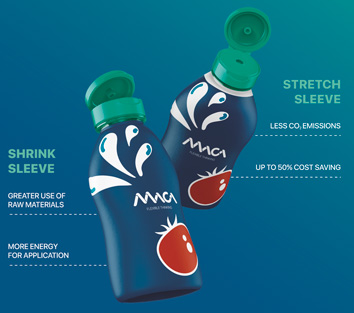 Come vincere a scaffale con un packaging d’impatto
Come vincere a scaffale con un packaging d’impatto
Immaginiamo di passeggiare in un supermercato, nel labirinto degli scaffali affollati. Immaginiamo di trovarci di fronte a quello delle salse, tanti barattoli in fila uno accanto all’altro che contengono tutti lo stesso prodotto. Sulla base di cosa ne scegliamo uno e non un altro? I fattori sono molteplici: la marca, la familiarità, ma ce ne è uno che in maniera inconscia influenza radicalmente le nostre scelte: il packaging.
Scegliere un packaging da forte impatto estetico consente al prodotto di emergere tra i tanti e di aumentare la probabilità che venga scelto.
Le strech sleeve e le shrink sleeve sono soluzioni di packaging perfette per ottenere questo risultato. Queste etichette tubolari, infatti, sono in grado di rivestire l’intera superficie di un packaging primario o di unire insieme due packaging di forma e dimensione differenti come campioni gratuiti o offerte multipack. 
A differenza delle etichette autoadesive, le sleeve sono in grado di rivestire a 360° packaging dalle più disparate forme offrendo ai brand il vantaggio di personalizzare senza alcun limite i propri prodotti.
Le shrink sleeve e le stretch sleeve sono soluzioni esteticamente identiche, ma le stretch offrono più vantaggi in termini di cost saving e di sostenibilità.
Mentre le shrink sleeve rivestono il packaging primario attraverso il principio della termoretrazione, quindi con l’utilizzo di calore, le stretch sleeve, essendo elastiche, lo fanno grazie all’estensione.
Nel primo caso, quindi, c’è l’utilizzo di una grande quantità di energia che si traduce in maggiori costi e maggiore emissione di CO2 in atmosfera.
Le stretch sleeve, al contrario, essendo elastiche non hanno bisogno del calore per adattarsi al packaging primario e rappresentano una soluzione molto più vantaggiosa sia in termini di costi ridotti fino al 50% rispetto alle shrink sia in termini di minor impatto ambientale. La materia prima con cui vengono realizzate è il polietilene: un materiale riciclabile al 100%, un ulteriore vantaggio che, insieme al processo produttivo più pulito e a basso consumo energetico, rende questa soluzione più green e adatta a un sistema di economia circolare.
Le stretch sleeve sono la soluzione di punta dell’azienda di flexible packaging Maca.
Il reparto di Ricerca e Sviluppo dell’azienda italiana ha messo a punto materiali e processi produttivi con risultati molto apprezzati in ambito europeo e fino a oggi ineguagliati.
Un esempio sono le linee dedicate a yogurt e dessert dove la sleeve viene applicata dal basso, senza necessità di capovolgere il bicchiere, lasciando pulito il lid oppure linee per contenitori conici per gelati o latticini dove le stretch vengono accompagnate dal basso, superando l’ostacolo del bordo del vassoio che, di solito, sporge per consentire la saldatura del top.
Scopri l’azienda su www.macasrl.it o sul profilo LinkedIn @macasrl
The harsh law of attraction
How to win the shelf with impactful packaging
Suppose you’re walking in a supermarket, through a maze of crowded shelves.
Suppose you stop and search for sauces: lots of cans lined up, side by side, all containing the same product. What drives your choice of one over the other? There are many factors at work: brand, familiarity — but there is one in particular that will unconsciously and drastically affect your purchase decision: packaging.
A packaging which features a strong visual impact makes the product stand out among others and improves its chance of being selected.
Stretch sleeves and shrink sleeves are the ideal packaging solutions to achieve this. These tubular labels can coat the entire surface of the primary packaging or group together two packages of different shape and size (think free samples or multi-pack deals).
Unlike self-adhesive labels, sleeves ensure full coating for the most diverse packaging shapes, thus giving brands the opportunity to freely customize their products.
Despite being apparently identical to shrink sleeves, stretch sleeves offer more benefits in terms of cost saving and sustainability.
While shrink sleeves implement primary packaging coating by heat shrinking, hence employing heat, the elastic stretch sleeves do it by simply extending.
This means shrink sleeves require a great amount of energy, resulting in higher costs and CO2 emission in our atmosphere.
Conversely, stretch sleeves are elastic and therefore don’t require heat to adjust to the primary packaging: they are far more convenient both in terms of costs, which is reduced up to 50% compared to shrink sleeves, and their lower environmental impact. The raw material used in their production is polyethylene, a fully recyclable material; with this benefit and their cleaner, energy-efficient production process, they constitute a greener solution suitable for circular economies.
Stretch sleeves are the flagship product of Maca, Italian company which specializes in flexible packaging.
Their R&D department has developed materials and production processes showing remarkable performance; they have been highly praised in Europe and are unequalled to this day.
Consider for example lines reserved for yogurts and desserts: sleeves are applied from the bottom, without turning the glass upside down or leaving stains on the lid. In lines reserved for conical boxes for ice creams or dairy products, stretch sleeves are guided from the bottom, overcoming the typical issue with tray edges (which usually protrude to allow top sealing).
Find out more about MACA on www.macasrl.it or through their LinkedIn profile @macasrl









